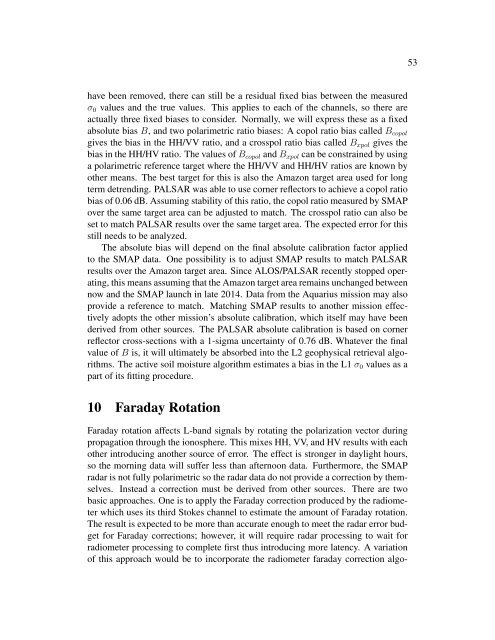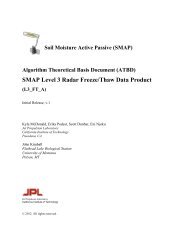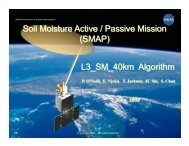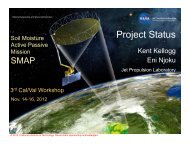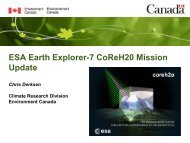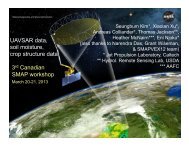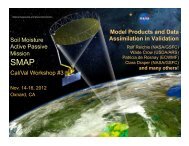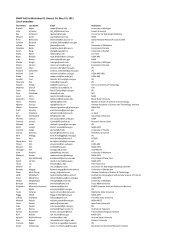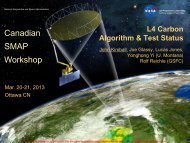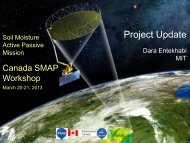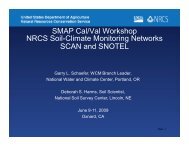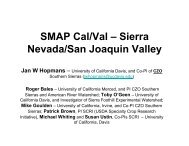(ATBD) SMAP Level 1 Radar Data Products - NASA
(ATBD) SMAP Level 1 Radar Data Products - NASA
(ATBD) SMAP Level 1 Radar Data Products - NASA
You also want an ePaper? Increase the reach of your titles
YUMPU automatically turns print PDFs into web optimized ePapers that Google loves.
53<br />
have been removed, there can still be a residual fixed bias between the measured<br />
σ 0 values and the true values. This applies to each of the channels, so there are<br />
actually three fixed biases to consider. Normally, we will express these as a fixed<br />
absolute bias B, and two polarimetric ratio biases: A copol ratio bias called B copol<br />
gives the bias in the HH/VV ratio, and a crosspol ratio bias called B xpol gives the<br />
bias in the HH/HV ratio. The values of B copol and B xpol can be constrained by using<br />
a polarimetric reference target where the HH/VV and HH/HV ratios are known by<br />
other means. The best target for this is also the Amazon target area used for long<br />
term detrending. PALSAR was able to use corner reflectors to achieve a copol ratio<br />
bias of 0.06 dB. Assuming stability of this ratio, the copol ratio measured by <strong>SMAP</strong><br />
over the same target area can be adjusted to match. The crosspol ratio can also be<br />
set to match PALSAR results over the same target area. The expected error for this<br />
still needs to be analyzed.<br />
The absolute bias will depend on the final absolute calibration factor applied<br />
to the <strong>SMAP</strong> data. One possibility is to adjust <strong>SMAP</strong> results to match PALSAR<br />
results over the Amazon target area. Since ALOS/PALSAR recently stopped operating,<br />
this means assuming that the Amazon target area remains unchanged between<br />
now and the <strong>SMAP</strong> launch in late 2014. <strong>Data</strong> from the Aquarius mission may also<br />
provide a reference to match. Matching <strong>SMAP</strong> results to another mission effectively<br />
adopts the other mission’s absolute calibration, which itself may have been<br />
derived from other sources. The PALSAR absolute calibration is based on corner<br />
reflector cross-sections with a 1-sigma uncertainty of 0.76 dB. Whatever the final<br />
value of B is, it will ultimately be absorbed into the L2 geophysical retrieval algorithms.<br />
The active soil moisture algorithm estimates a bias in the L1 σ 0 values as a<br />
part of its fitting procedure.<br />
10 Faraday Rotation<br />
Faraday rotation affects L-band signals by rotating the polarization vector during<br />
propagation through the ionosphere. This mixes HH, VV, and HV results with each<br />
other introducing another source of error. The effect is stronger in daylight hours,<br />
so the morning data will suffer less than afternoon data. Furthermore, the <strong>SMAP</strong><br />
radar is not fully polarimetric so the radar data do not provide a correction by themselves.<br />
Instead a correction must be derived from other sources. There are two<br />
basic approaches. One is to apply the Faraday correction produced by the radiometer<br />
which uses its third Stokes channel to estimate the amount of Faraday rotation.<br />
The result is expected to be more than accurate enough to meet the radar error budget<br />
for Faraday corrections; however, it will require radar processing to wait for<br />
radiometer processing to complete first thus introducing more latency. A variation<br />
of this approach would be to incorporate the radiometer faraday correction algo-


